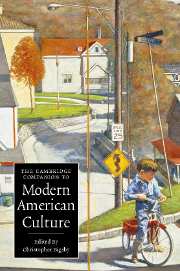Book contents
- Frontmatter
- 1 Introduction: What, then, is the American?
- 2 The American century
- 3 The regions and regionalism
- 4 Immigration to the United States in the twentieth century
- 5 Religion in the United States in the twentieth century: 1900-1960
- 6 Shifting boundaries: religion and the United States: 1960 to the present
- 7 The Hispanic background of the United States
- 8 African Americans since 1900
- 9 Asian Americans
- 10 Women in the twentieth century
- 11 Queer America
- 12 The United States, war, and the twentieth century
- 13 The culture of the Cold War
- 14 Secret America: the CIA and American culture
- 15 Vietnam and the 1960s
- 16 New York City and the struggle of the modern
- 17 Music: sound: technology
- 18 African American music of the twentieth century
- 19 Hollywood cinema
- 20 Popular culture
- 21 Theatre
- 22 Society and the novel in twentieth-century America
- 23 “Preferring the wrong way”: mapping the ethical diversity of US twentieth-century poetry
- Index
- Series List
1 - Introduction: What, then, is the American?
Published online by Cambridge University Press: 28 January 2007
- Frontmatter
- 1 Introduction: What, then, is the American?
- 2 The American century
- 3 The regions and regionalism
- 4 Immigration to the United States in the twentieth century
- 5 Religion in the United States in the twentieth century: 1900-1960
- 6 Shifting boundaries: religion and the United States: 1960 to the present
- 7 The Hispanic background of the United States
- 8 African Americans since 1900
- 9 Asian Americans
- 10 Women in the twentieth century
- 11 Queer America
- 12 The United States, war, and the twentieth century
- 13 The culture of the Cold War
- 14 Secret America: the CIA and American culture
- 15 Vietnam and the 1960s
- 16 New York City and the struggle of the modern
- 17 Music: sound: technology
- 18 African American music of the twentieth century
- 19 Hollywood cinema
- 20 Popular culture
- 21 Theatre
- 22 Society and the novel in twentieth-century America
- 23 “Preferring the wrong way”: mapping the ethical diversity of US twentieth-century poetry
- Index
- Series List
Summary
Every year, on March 22, Riverside, Iowa, celebrates an event that has not yet happened and never will. It is the place and date designated for the birth of Captain James Tiberius Kirk, Captain of the Star Ship Enterprise. America has so successfully colonized the future that it has mastered the art of prospective nostalgia. Its natural tense is the future perfect. It looks forward to a time when something will have happened. It is a place, too, where fact and fiction, myth and reality dance a curious gavotte. It is a society born out of its own imaginings.
There are those who believe they can remember alternative past lives. The science fiction writer Philip K. Dick claimed to remember a different present life. In his case it may have had something to do with amphetamines, but in fact we do inhabit different and parallel presents. The 1920s constituted the jazz age, except for those who tapped their feet to different rhythms. The 1960s were about drugs and rock and roll, except for the majority for whom they were not. Thoreau once wrote of his wriggling his toes in the mud of Walden Pond in search of the rock beneath. The search for a secure foundation is understandable but cannot always be satisfied. Nineteenth century American writers dealt in symbols for a reason. Unlike the metaphor, the symbol suggested a field of meaning, an ambiguity which in the end perhaps could more truthfully capture a world in flux, desperate for clear definitions yet aware that in stasis lay a denial of, rather than a route to, meaning in a society wedded to the idea of possibility, always coming into being and never fixed.
- Type
- Chapter
- Information
- The Cambridge Companion to Modern American Culture , pp. 1 - 32Publisher: Cambridge University PressPrint publication year: 2006
- 1
- Cited by



